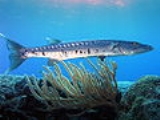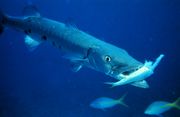
Great barracuda
Encyclopedia
The great barracuda is a species of barracuda
. Great barracudas often grow over 6 feet (1.8 m) long and are a type of ray-finned fish.
with powerful jaw
s. The lower jaw of the large mouth juts out beyond the upper. Barracudas possess strong, fang-like teeth that are unequal in size and set in sockets in the jaws and on the roof of the mouth. The head is quite large and is pointed and pike
-like in appearance. The gill
-covers do not have spines and are covered with small scales. The two dorsal fin
s are widely separated, with the first having five spines and the second having one spine and nine soft rays. The second dorsal fin equals the anal fin in size and is situated more or less above it. The lateral line
is prominent and extends straight from head to tail
. The spinous dorsal fin is situated above the pelvis. The hind end of the caudal fin is forked or concave, and it is set at the end of a stout peduncle. The pectoral fins are placed low down on the sides. The barracuda has a large swim bladder.
In general, the barracuda's coloration is dark green or a blue type coloration or grey above chalky-white below. This varies somewhat. Sometimes there is a row of darker cross-bars or black spots on each side. The fins may be yellowish or dark.
 Barracudas appear in open seas. They are voracious predators
Barracudas appear in open seas. They are voracious predators
and hunt using a classic example of lie-in-wait or ambush
. They rely on surprise and short bursts of speed (up to 27 mph (43 km/h)[2]) to overrun their prey, sacrificing maneuverability. Barracudas are more or less solitary in their habits.
Young and half-grown fish frequently congregate in shoals.
Their food is composed almost totally of fish of all kinds.
Large barracudas, when gorged, may attempt to herd a school of prey fish in shallow water,
where they guard over them until they are ready for another hunt.
Barracuda
The barracuda is a ray-finned fish known for its large size and fearsome appearance. Its body is long, fairly compressed, and covered with small, smooth scales. Some species could reach up to 1.8m in length and 30 cm in width...
. Great barracudas often grow over 6 feet (1.8 m) long and are a type of ray-finned fish.
Appearance
Barracudas are elongated fishFish
Fish are a paraphyletic group of organisms that consist of all gill-bearing aquatic vertebrate animals that lack limbs with digits. Included in this definition are the living hagfish, lampreys, and cartilaginous and bony fish, as well as various extinct related groups...
with powerful jaw
Jaw
The jaw is any opposable articulated structure at the entrance of the mouth, typically used for grasping and manipulating food. The term jaws is also broadly applied to the whole of the structures constituting the vault of the mouth and serving to open and close it and is part of the body plan of...
s. The lower jaw of the large mouth juts out beyond the upper. Barracudas possess strong, fang-like teeth that are unequal in size and set in sockets in the jaws and on the roof of the mouth. The head is quite large and is pointed and pike
Esox
Esox is a genus of freshwater fish, the only living genus in the family Esocidae — the esocids which were endemic to North America, Europe and Eurasia during the Paleogene through present.The type species is E. lucius, the northern pike...
-like in appearance. The gill
Gill
A gill is a respiratory organ found in many aquatic organisms that extracts dissolved oxygen from water, afterward excreting carbon dioxide. The gills of some species such as hermit crabs have adapted to allow respiration on land provided they are kept moist...
-covers do not have spines and are covered with small scales. The two dorsal fin
Dorsal fin
A dorsal fin is a fin located on the backs of various unrelated marine and freshwater vertebrates, including most fishes, marine mammals , and the ichthyosaurs...
s are widely separated, with the first having five spines and the second having one spine and nine soft rays. The second dorsal fin equals the anal fin in size and is situated more or less above it. The lateral line
Lateral line
The lateral line is a sense organ in aquatic organisms , used to detect movement and vibration in the surrounding water. Lateral lines are usually visible as faint lines running lengthwise down each side, from the vicinity of the gill covers to the base of the tail...
is prominent and extends straight from head to tail
Tail
The tail is the section at the rear end of an animal's body; in general, the term refers to a distinct, flexible appendage to the torso. It is the part of the body that corresponds roughly to the sacrum and coccyx in mammals, reptiles, and birds...
. The spinous dorsal fin is situated above the pelvis. The hind end of the caudal fin is forked or concave, and it is set at the end of a stout peduncle. The pectoral fins are placed low down on the sides. The barracuda has a large swim bladder.
In general, the barracuda's coloration is dark green or a blue type coloration or grey above chalky-white below. This varies somewhat. Sometimes there is a row of darker cross-bars or black spots on each side. The fins may be yellowish or dark.
Behavior

Predatory fish
Predatory fish are fish that predate upon other fish or animals. Some predatory fish include perch, muskie , pike, walleye, salmon.Levels of large predatory fish in the global oceans are estimated to be about 10% of their pre-industrial levels...
and hunt using a classic example of lie-in-wait or ambush
Ambush
An ambush is a long-established military tactic, in which the aggressors take advantage of concealment and the element of surprise to attack an unsuspecting enemy from concealed positions, such as among dense underbrush or behind hilltops...
. They rely on surprise and short bursts of speed (up to 27 mph (43 km/h)[2]) to overrun their prey, sacrificing maneuverability. Barracudas are more or less solitary in their habits.
Young and half-grown fish frequently congregate in shoals.
Their food is composed almost totally of fish of all kinds.
Large barracudas, when gorged, may attempt to herd a school of prey fish in shallow water,
where they guard over them until they are ready for another hunt.

